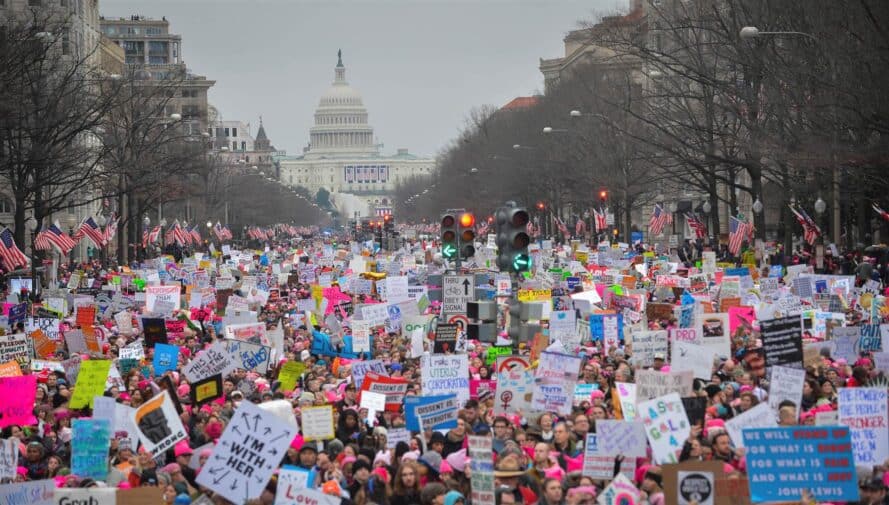

HUNDREDS OF thousands took to the streets in cities across the US on January 20 and 21 to mark the anniversary of the huge protests against the inauguration of Donald Trump and the threat he poses to women’s rights. This year authorities estimated that well over 100,000 people attended the New York rally and that some 300,000 showed up in Los Angeles. The pussy hats were back along with the homemade placards, plus the rage at Trump’s actions over the past year and fear of what’s to come.
Trumps “misspeak” on January 20- “right now, in a number of states, the laws allow a baby to be born from his or her mother’s womb in the ninth month. It is wrong, it has to change”, undoubtedly caused millions to laugh at him. But the real story is that he was speaking at a right-wing protest calling for the end of the historic Roe vs Wade. He plainly has this historic gain for US women in his sights.
The Women’s March shows the continued strength of feeling against Trump’s presidency, the polarisation of politics in America and the potential for change. The current movement looks to celebrities, but despite the common problems all women face – sexual harassment, wage discrimination and general misogyny – our experience of sexism is defined by our class and most of us aren’t rich and famous.
The US has an even meaner welfare state than Britain and working-class women there face a greater struggle to access childcare and benefits. The wage gap exists in a context of a minimum wage of only $7.25. The number of Americans having to work a second job is rising, and this too affects women more than men.
Lily Hendricks, protesting in Indiana, told the New York Times, “I want an equal platform to stand on, and access to health care rights and reproductive choices.” Marah Rockhold from Virginia said “We need more respect in 2018. Respect that would go toward the M.M.I.W. [missing and murdered indigenous women], the pipeline and honoring native women in the US and Canada.” 11-year-old Xenaya in New York wants “Equal pay… and equal rights.”
To move from mass protests to a movement that can win victories, a political programme is needed and the demands of the rich and the demands of the working class will naturally differ. The privilege of the powerful would subsume the needs of the many. Only a working class women’s movement could consistently struggle for the rights of the mass of women.
The Power to the Polls rally in Nevada on 21st February urged women to use their vote to effect political change, with a number of speakers urging a vote for the Democrats at the upcoming midterm elections.
Democrats
But while the 2017 Inaugural marches functioned as a rallying cry against Trump’s election victory, the 2018 iteration served was heavily taken over as a nationwide political rally. Democratic elected officials and liberal celebrities urged attendees to channel their energy and frustration with Trump’s policies into November’s midterm elections – i.e. into voting Democrat.
However, the Democrat’s stale brand of politics were rejected by voters in the Presidential race, not only because Trump had built a right-wing political movement but also because of the dead-end of Hilary Clinton’s unwavering support for Wall Street, wars and occupations and her “Lean In” feminism.
The co-option of the Women’s March supporters into the dead end of the Democrats would be a blow for the resistance to Trump. The conclusion of many Sanders supporters – that America needs a new party, expressed through their turn towards the Democratic Socialists – can be a positive step if a new party is built founded on the principles of working class independence from the capitalists and their political agents